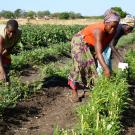Abstract from the article:
Vegetable amaranth (Amaranthus sp.), a leafy vegetable crop consumed around the world, is actively promoted as a source of essential micronutrients to at-risk populations. Such promotion makes micronutrient content essential to the underlying value of this crop. However, the extent to which micronutrient content varies by effect of genotype is not clear, leaving breeders uninformed on how to prioritize micronutrient contents as the criteria for selection among other performance parameters. A total of 32 entries across seven Amaranthus species were field-grown and analyzed for iron (Fe), magnesium (Mg), calcium (Ca), Zinc (Zn), yield, height, and canopy spread comprising 20 entries at New Jersey in 2013; 12 entries at Arusha, Tanzania, in 2014; and 20 entries at New Jersey in 2015. The genotype effect was significant in all trials for Fe, Mg, Ca, Zn, total yield, marketable yield, height, and canopy spread. The Fe content range was above and below the breeding target of 4.2 mg/100 g Fe in all environments except for New Jersey 2015, where all entries were found to accumulate in levels below the target. All entries in each of the environments contained levels of Ca and Mg above breeding targets, 300 mg/100 g Ca and 90 mg/100 g Mg. None of the entries in any environment met the Zn breeding target of 4.5 mg/100 g Zn.
Byrnes, D.R., F. F. Dinssa, S. C. Weller, and J. E. Simon. 2017. "Elemental Micronutrient Content and Horticultural Performance of Various Vegetable Amaranth Genotypes" Journal of the American Society for Horticultural Science. 142(4):265–271. doi: 10.21273/JASHS04064-17
If you encounter problems accessing the full text of this journal article, you may contact one of the authors listed here or the corresponding author: jimsimon@rutgers.edu.

